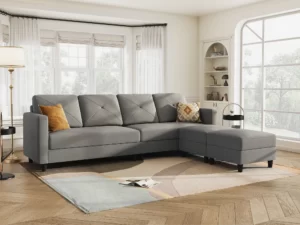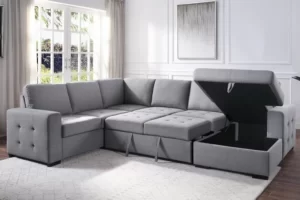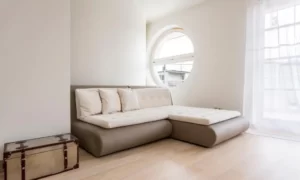Last updated on June 22nd, 2023 at 06:01 am
When it comes to furnishing our living spaces, the selection of a sofa is crucial for both aesthetics and comfort. With so many options available, choosing between a traditional sofa and a sectional sofa can be challenging.
There are fundamental distinctions between them, despite the fact that they serve the same purpose of providing a cozy place to unwind and entertain.
Understanding these distinctions is essential for making an informed decision that complements your lifestyle and your home’s layout.
This article will examine the differences between sectional sofas and traditional sofas. We will investigate their designs, configurations, functionality, and benefits.
Therefore, if you’re considering a new seating arrangement for your living room, continue reading to determine which one best meets your requirements.
Sectional Sofa
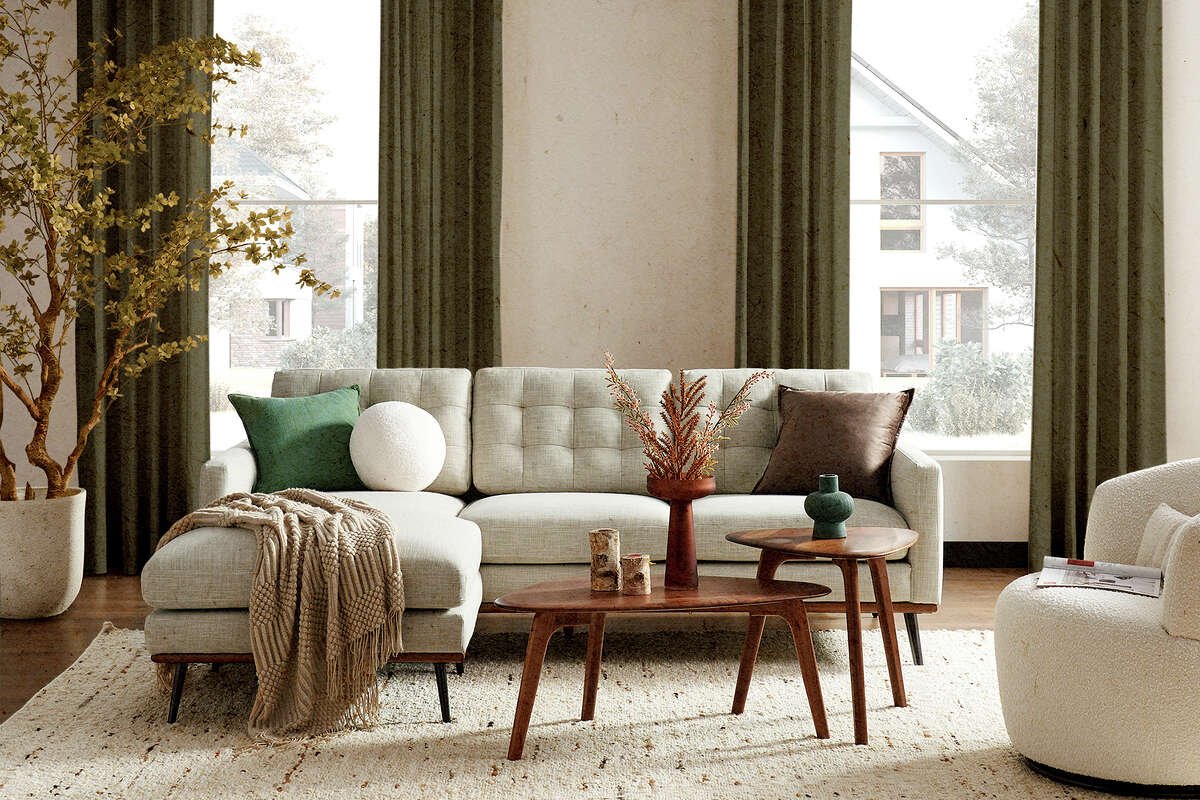
Photo Credit: sfgate
What Makes a Sectional Sofa?
A sectional sofa is a type of seating furniture that consists of numerous sections or pieces that can be configured in a variety of ways. Typically, these parts are designed to form an L-shape, U-shape, or even a curved shape when assembled.
Individual sections of a sectional settee may consist of loveseats, chaise lounges, armless chairs, and corner sections.
Versatility is one of the defining features of a sectional settee. The modular design enables you to tailor the configuration to your space and requirements. Alternatively, you can separate the sections to create multiple seating areas in a room.
This adaptability makes sectional an excellent option for homes with an open floor plan or living rooms that require a large number of seats.
In addition, sectional sofas typically provide ample seating space, making them ideal for large families or individuals who frequently host visitors.
The various sections also offer a variety of seating options, enabling everyone to find their ideal spot, whether they prefer a recliner, a chaise lounge for relaxation, or a traditional seat with armrests.
They are available in a variety of patterns, materials, and colors, allowing you to find one that complements your interior design and personality.
There is a sectional sofa for every aesthetic preference, ranging from streamlined and modern designs to more traditional or eclectic options.
Different Configurations of Sectional Sofas
Sectional sofas offer a great deal of configuration flexibility. You can choose from a variety of configurations to accommodate your specific requirements and living space layout. Some common configurations include:
This configuration consists of two sections that create a right angle, creating an L-shape. It is a popular choice for installation in corners.
This configuration is comprised of three sections that form a U-shape. It offers adequate seating and is ideal for spacious living rooms.
This configuration features curved sections that can be used to create a more elegant and distinctive seating arrangement.
Advantages of Sectional Sofas
Numerous households choose sectionals due to their numerous advantages. Sofass offers numerous seating options, making them ideal for large families or individuals who frequently host visitors.
With the ability to rearrange the sections, sectional provide adaptability to various room layouts and changing preferences.
Comfort: Sectional sofas typically feature deep cushions and luxurious upholstery, guaranteeing a relaxing experience.
Disadvantages of Sectional Sofas
Sectional sofas typically require more space than conventional sofas due to their larger dimensions and multiple sections. It may be difficult to accommodate a sectional sofa in a compact living room without overcrowding the area.
The size and configuration of sofas may limit the room layout options available to you. Due to its fixed configuration, it may be difficult to rearrange the furniture or position it in different areas of the room.
Standard Couches

Photo Credit: thespruce
Features of Regular Sofas
Regular sofas, known as traditional or standard couches, have several distinguishing characteristics. These sofas are designed as single-piece seating furniture and are typically intended for two to three individuals. Here are the distinguishing characteristics of standard sofas:
Standard sofas feature a sturdy structure that provides stability and support. Typically, the frame is made of wood or metal, assuring its durability and strength.
These sofas are designed to adequately accommodate two to three individuals. They provide enough seating space for people to sit and unwind.
Standard sofas include a backrest that provides back support for the user. Depending on the manner of the sofa, the backrest can range in height and style from low to high backs.
Standard sofas typically include armrests on both sides. The armrests offer a place to rest the arms while seated and add to the overall comfort and relaxation.
Standard sofas are furnished with cushioning for added comfort. Typically, these cushions are stuffed with polyurethane, feathers, or a combination of the two. They provide a reclining surface that is soft and comfortable.
The upholstery of standard sofas can be manufactured from a variety of materials, including fabric, leather, and synthetics. The selection of sofa upholstery affects its overall aspect, texture, and durability.
Standard sofas are available in a variety of styles to accommodate various interior design preferences. Loveseats, Chesterfields, and Lawson sofas are some popular designs. Each style has distinctive elements of design and aesthetic appeal.
Regular sofas are versatile and can be placed in a variety of spaces, including living rooms, family rooms, and dens. They provide comfortable seating options for socializing, unwinding, and television viewing.
Depending on the manufacturer and retailer, customization options may be available for standard sofas. This enables customers to select the upholstery material, color, and sometimes even dimension to suit their preferences and available space.
Standard sofas are designed to be durable and able to withstand regular use. The quality of the used materials and the frame’s construction contributes to the durability and longevity of the sofa as a whole.
Types of Regular Sofas
Standard sofas are available in various styles to accommodate various preferences and interior design motifs. The following are prevalent types of standard sofas:
Loveseats are small sofas designed to accommodate two people in comfort. They are ideal for small living spaces or as additional seating in larger rooms.
Chesterfield sofas are recognizable by their tufting and rolled armrests. Typically constructed from high-quality leather, they emanate a classic and refined aesthetic.
Lawson sofas are distinctive for their relaxed and informal appearance. Common characteristics include square or rectangular cushions, a low back, and streamlined lines.
Pros of Regular Sofas
Numerous households opt for conventional sofas due to their numerous benefits: Regular sofas are typically more compact than sectional sofas, making them ideal for small living rooms and apartments.
Due to their one-piece construction, conventional sofas offer greater placement and room configuration flexibility. They can be readily moved or rearranged as necessary.
Standard sofas are available in a variety of patterns, fabrics, and colors, allowing you to find the ideal match for your interior design and personality.
Cons of Regular Sofas
While standard sofas have their benefits, there are a few factors to consider: Standard sofas seat two to three individuals, which may not be sufficient for larger families or individuals who frequently host gatherings.
Regular sofas do not offer the same degree of configurability as sectional sofas. Their layout cannot be rearranged or reconfigured to accommodate varying requirements or room configurations.
Depending on the design and quality of the conventional sofa, certain models may not offer the same level of comfort as sofas. Before making a purchase, it is vital to evaluate seating comfort.
Differences Between Sectional and Traditional Sofas

Photo Credit: walmart
Now that we’ve examined the characteristics of sectional sofas and conventional sofas separately, let’s examine the primary distinctions between the two:
Size and Shape
Certainly! Here are the details in English: One of the primary distinctions between sectional sofas and conventional sofas is their size and shape. They are typically larger and more voluminous than conventional sofas.
This is because sofas are composed of multiple sections that can be rearranged to accommodate various room layouts.
Typically, the various sections, such as a chaise longue, loveseat, or corner piece, are connected in an L- or U-shape. This modular design permits greater flexibility in arranging the sofa according to individual preferences and the room’s configuration.
In contrast, standard sofas are typically designed for smaller spaces and are smaller in size. Typically, they have a singular, continuous seating surface with no separate sections.
Standard sofas are typically available in two-seaters, three-seaters, and even larger sizes. These sofas are ideal for tiny living rooms, apartments, and other spaces with limited space.
The choice between a sectional sofa and a conventional sofa ultimately depends on individual preference, available space, and the intended aesthetic and functionality.
They are frequently preferred for larger living rooms or open floor plans because they can provide ample seating and foster a more relaxed, reclining environment.
Regular sofas, on the other hand, are adaptable and can fit into a variety of room sizes and layouts, making them a popular option for small rooms.
It is important to note that there are size and shape variations within both sectional and conventional sofas and that different manufacturers may offer various options. Before deciding on a sofa, it is always advisable to measure your space and consider your specific requirements.
Versatility and Configuration
In terms of configuration, sectional sofas offer a greater degree of adaptability. With sofas, you can rearrange the various sections to create a variety of layouts to suit your requirements and preferences.
This adaptability allows you to customize the sofa to suit a variety of room layouts or to accommodate evolving design preferences.
In contrast, standard sofas typically have a design and configuration that is fixed. Once you purchase a conventional sofa, your options for rearranging its components are limited.
Although you may be able to move the sofa within a room, it cannot be readily reshaped or rearranged. The modular nature of sofas allows you to construct L- and U-shaped configurations, as well as separate individual seating units.
This adaptability is especially useful in larger spaces or rooms with unusual layouts, where you may wish to maximize available space or create distinct seating areas.
Additionally, sectional sofas frequently include recliners, chaise lounges, and ottomans, which enhance the seating arrangement’s versatility and convenience. You can arrange these elements according to your preferences and relaxation requirements.
The ability to reconfigure sofas is advantageous for households with frequent visitors or varying seating needs.
It enables you to create intimate conversation nooks, expand the space for larger gatherings, or even transform the sofa into a temporary bed for overnight visitors.
Seating Capacity
Sectional sofas typically offer more seating capacity than conventional sofas. Due to its multiple sections and larger size, it can accommodate larger groups of people, making them ideal for families and individuals who frequently host visitors. However, standard sofas are typically designed to accommodate two to three individuals.
Space Requirements
The amount of space required by sectional sofas and standard sofas can vary considerably. Due to their larger size and multiple sections, sofas typically demand more floor space.
In contrast, standard sofas are typically more space-efficient and can fit into smaller living rooms or apartments with limited square footage.
Design and Style
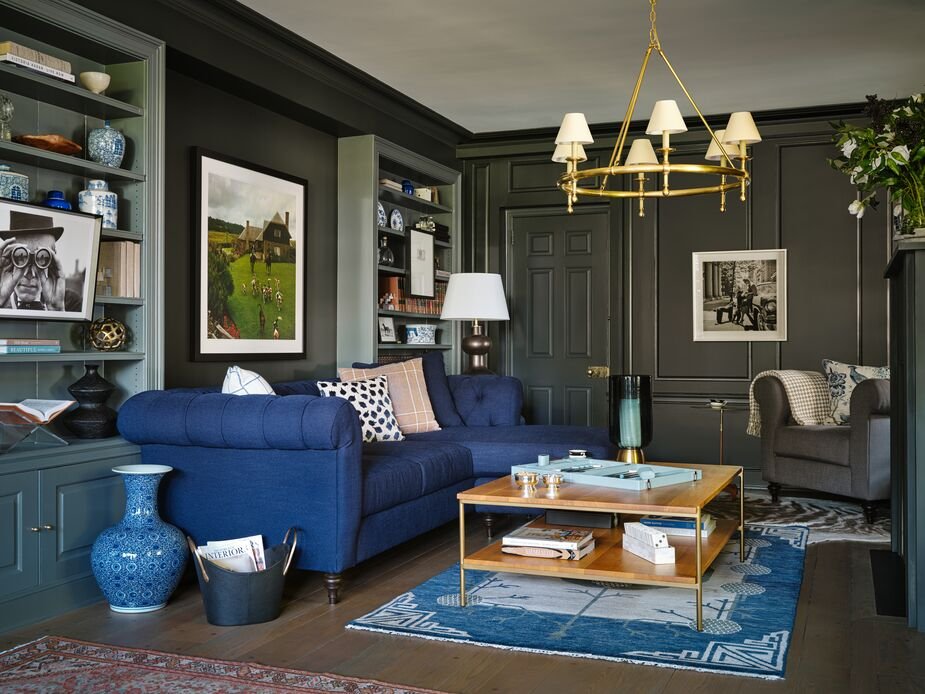
Photo Credit: onekingslane
Both sectional sofas and traditional sofas are available in a variety of designs and styles to accommodate various sensibilities and preferences.
Nevertheless, they are typically viewed as more modern and contemporary due to their streamlined lines and modular configurations.
Regular sofas, on the other hand, comprise a broader range of styles, such as classic, traditional, and contemporary designs, to accommodate a variety of interior design themes.
FAQs (Frequently Asked Questions)
Can a sectional sofa be rearranged?
Yes, the versatility of sectional sofas is one of their benefits. Individual sections of a sectional sofa can be reconfigured to create various seating configurations, allowing you to adapt the sofa to your changing requirements or room layout.
Can regular sofas accommodate large gatherings?
Standard sofas are typically designed to comfortably seat two to three individuals. Although they may not be optimal for large gatherings, a standard sofa can be supplemented with additional seating options, such as chairs or ottomans, to accommodate additional guests.
Which type of sofa is better for small spaces?
Due to their smaller size, standard sofas are typically preferable for small rooms. They can nestle into tight corners or small living rooms without dominating the space.
Nonetheless, if you still desire the adaptability of a sectional sofa, you may want to consider a smaller sectional sofa that is designed for compact spaces.
Are sectional sofas more expensive than regular sofas?
The price of sectional sofas and standard sofas can vary depending on brand, material, and style. Due to their larger dimensions and multiple sections, sofas tend to be more expensive.
Before making a purchase, it is essential to assess prices and evaluate the features and quality of each sofa.
Can I add additional seating to a regular sofa?
Yes, you can complement a standard settee with chairs, ottomans, or even a matching loveseat if you need additional seating. This allows you to construct a seating arrangement that meets your needs and, if necessary, accommodates additional guests.
Do both types of sofas come with warranties?
Sofa warranties can vary based on the manufacturer and retailer. Reviewing the warranty terms and conditions for each sofa model under consideration is essential.
Some sectional sofas and standard sofas may include warranties covering structural integrity, upholstery, or manufacturing defects.
Before making a purchase decision, be sure to inquire about the warranty details.
Bottom Line
Understanding the distinction between a sectional sofa and a conventional sofa is essential when selecting the ideal seating option for your living room. Sectional sofas feature adaptability, ample seating capacity, and a contemporary design.
With their adaptable sections, they can facilitate larger gatherings and accommodate various room layouts. Nevertheless, they may require additional space and have a fixed design.
In contrast, traditional sofas are space-efficient and available in a variety of designs, making them suitable for smaller living spaces.
While their seating capacity and configuration options may be limited, they provide a classic and comfortable seating solution.


